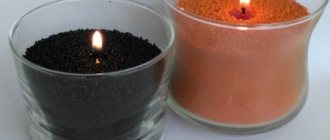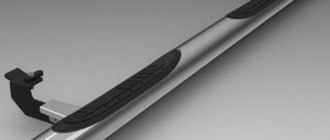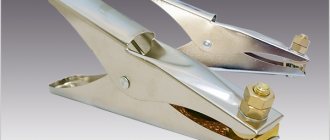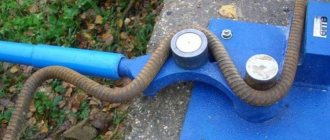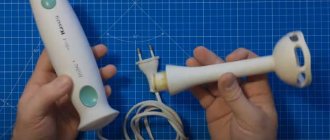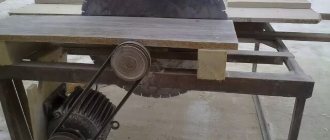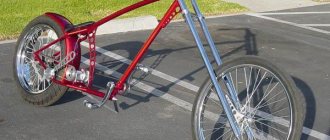It is believed that cinder block is excellent for the construction of residential buildings and other buildings, due to its availability and compliance with the required characteristics.
To further reduce the cost of the material, many begin to produce it themselves.
This can be done either using improvised means or using a special machine. The device is not cheap, but you can also build it yourself.
Description of the device
A vibrating cinder block machine is equipment that helps compact the mortar poured into molds . This is done so that there are no voids or air bubbles in the mass for making the block. The finished cinder block must fully comply with GOST, otherwise it cannot be used for building a house.
Important! Blocks that were made using a brick press always have better frost resistance, resistance to deformation, and strength than those that were made using other technologies.
The vibrating machine consists of several parts. In its lower part there is a frame where the vibrating table is located. It rests on rubber cushions. The vibrating table has several vibrators with adjustable strength.
The design has a backfill device for pouring concrete mixture . This is a tin container that allows you to pour concrete into the mold evenly and quickly. There is also a punch and a die.
The design includes a device for pressing the matrix with the pallet to the vibrating table. Vibrators for cinder blocks are equipped with electric motors and a drive.
Some vibrating machines use void formers. They are inserted into forms with concrete mixture and make holes in them. The output is a hollow cinder block.
What are they?
Machines for the production of cinder blocks are:
- automated stations;
- semi-automatic machines;
- manual equipment.
A fully automated machine is more suitable for enterprises that constantly sell cinder blocks. The productivity of such equipment is up to 1000 blocks per hour.
All you need to do is simply pour the cinder block ingredients into the container and press the start button. The mini-station will independently mix, pour, and compact stones ; the operator only needs to monitor the work. The advantage of such a vibrating machine is the lack of human intervention, the disadvantage is the high cost. Similar devices are produced by Bess.
Semi-automatic machines already require human intervention. Some operations here are automatic, but others will have to be performed manually. For example, in different configurations, the machine itself mixes the mixture for the stone, and the operator needs to lower the vibropress.
In other machines, the operator only participates in pouring the finished solution, and the rest is done by the vibrating table. The production of such machines is carried out by the Sibir company.
Manual equipment is considered the least productive, but it fully satisfies the needs for cinder blocks in private construction. The average cost of such a device will cost 200,000 rubles. A good representative is a device from VibropressStroy .
Reference! Depending on the type of block formation, machines can be mobile or stationary. The first ones are small in size and stones can be produced immediately on the construction site. Stationary equipment requires a lot of space, but its productivity is higher.
Principle of operation
All of the listed machines operate on a similar principle:
- The prepared solution is poured into a special container.
- The mixture is transported into the matrix.
- With the help of vibration, the mixture is leveled and compacted.
- If there are devices for voids, they are inserted into blocks with mortar and are strongly compacted under pressure and vibration.
- The matrix rises above the blocks and the finished mixture, already formed into blocks of the required size, is sent for drying.
The only difference between the devices is that in a fully automated machine all operations are performed independently. Even the mixing and transportation of the solution occurs automatically .
If the machine is manual, then the person must first prepare the slag mass in a concrete mixer, then pour it into molds, and then compact it well using a vibrating table. Again, you will have to carry the blocks to dry yourself.
Advantages of slag concrete blocks
The composition of cinder block (as well as foam block) is truly unique:
- Cinder concrete blocks have excellent heat and sound insulation.
- Such blocks have sufficient strength and durability.
- Good savings on cement. So, to prepare 36 pieces, one bag of cement will be used.
- Current Russian legislation does not provide for mandatory certification of either the slag concrete material itself or the equipment with which it is produced. That is, there is no need for mandatory testing for safety and quality.
Hence the conclusion: cinder block is the most profitable material for construction on your site, because in this case the process is fast, economical and reliable.
How to make a vibrating machine at home?
If the machine is needed for individual production of blocks when building your own house, then there is no point in purchasing expensive equipment. You can try making it yourself .
Before you begin preparing tools and materials, you need to find the drawings. Such schemes can be found on the Internet on construction forums. There people share their experiences and talk in detail about the collection of equipment and its operation.
Necessary materials
To create a machine for the production of cinder blocks with your own hands, you need the following materials :
- galvanized metal sheet 3 mm thick;
- 1 meter of steel pipe with a diameter of 7-9 cm;
- steel strip 3 mm thick, 30 cm long;
- electric motor with power up to 1 kW.
A sheet of galvanized metal is necessary to create a matrix into which concrete and slag mixtures will be poured. The thickness of 3 mm is just right for these purposes.
The steel tube must be prepared for void formers . It is unlikely that self-production will produce only solid blocks. You can choose the diameter of the pipe yourself, depending on what diameter of the void you want to get at the outlet.
Note! Solid blocks are used to construct load-bearing walls, and cinder blocks with voids are used for internal walls and partitions.
The electric motor will be useful for arranging the drive, due to which the solution will be compacted in the molds.
Necessary tools and consumables
Consumables for assembling a vibrating machine will require a large amount of fasteners: screws, nuts, bolts, anchors. You also need to prepare tools :
- angle grinder or grinder;
- welding machine;
- vice;
- a set of keys.
It is also better to prepare screwdrivers and a screwdriver (if available) in advance - with the help of these tools you can assemble the machine much faster. For an angle grinder you need to choose a disc that can work on metal. You can’t do without a welding machine - the vibrating machine must be made with high quality and last throughout the entire construction phase.
If you have no experience with welding, then you shouldn’t risk it - this procedure requires special skills. In this case, it is better to hire an experienced welder and explain the task to him. You will need hex keys and others, so it is better to have a good set.
Step by step procedure
After all the materials, tools and consumables are ready, you can begin manufacturing the machine:
- At the first stage, you need to decide on the size of future blocks. This indicator must be written down in the drawing. The most common option is 200x200x400 mm.
- When making a matrix for blocks, you need to take into account the following point: the height of the matrix will be 50 mm higher than the height of the finished block. For manufacturing, a sheet of steel is cut using a grinder. You need to cut this sheet in advance, and also take care of the presence of partitions between the forms.
- Using a welding machine, the cut strips are welded together on the outside.
- Production of void former. The metal pipe is cut into lengths less than the height of the matrix by 5 mm. The device must have a cone-shaped shape; this can be achieved by clamping the pipe in a vice and welding it. The tubes must be blind on all sides; at the end they are connected to each other by welding.
- The void former is welded to the matrix or a removable structure is made.
- Bolts are attached to the outer long wall of the mold, onto which the electric motor is installed.
Do not forget that there must be a metal apron on the top of the matrix. At the final stage, the finished machine is placed in a frame, cleaned and painted.
Features of the material
Cinder block is a building material that has proven itself to be one of the most durable and unpretentious. It has considerable dimensions, especially if you place an ordinary brick next to it. You can make slag blocks not only in a factory setting. Some craftsmen undertake this work at home. If you strictly adhere to the technology, you get high-quality and strong blocks from which you can build a house or any outbuilding.
If a decision has been made to independently produce such products, then a number of its features should be taken into account.
- Cinder block is a fireproof material. It does not ignite itself, and does not intensify an existing flame.
- Really good quality blocks make long-lasting and sustainable homes/outbuildings. Such buildings will not be harmed by harsh climatic conditions, hurricanes, or constant gusty winds.
- Repairing cinder block buildings does not require extra effort and free time - all work can be completed in a short time.
- Cinder blocks are also distinguished by their large sizes, thanks to which buildings made from them can be erected very quickly, which pleases many builders.
- This material is durable. Buildings built from it can stand for more than 100 years without losing their previous characteristics.
- Another feature of cinder block is its soundproofing component. Thus, in dwellings made from this material there are no annoying street noises.
- The production of cinder blocks is carried out using various raw materials, so it is possible to select the optimal products for any conditions.
- What distinguishes cinder block is that it is not subject to attacks by various kinds of parasites or rodents. In addition, it does not rot, so it does not have to be coated with antiseptic solutions and other similar compounds designed to protect the base.
- Despite their decent dimensions, such blocks are light in weight. This feature is noted by many masters. Due to their lightness, these materials can be easily moved from one place to another without calling a crane. However, it must be taken into account that some types of such products are still quite heavy.
- Cinder block is not afraid of low temperatures.
- These blocks are distinguished by their high heat capacity, thanks to which they make cozy and warm homes.
- Temperature fluctuations do not harm the cinder block.
Cinder block buildings are usually decorated with decorative materials to give a more aesthetic appearance.
However, it is very important to remember that the cinder block cannot be covered with ordinary plaster (any “wet” work with this material should not be carried out). You can also use a special decorative block, which is often used instead of expensive cladding. When working with cinder block, it is important to take into account one important feature - this material is characterized by high water absorption, so it must be protected from contact with moisture and dampness
Otherwise, the blocks may collapse over time. Unfortunately, the geometry of the slag blocks leaves much to be desired. That is why, when laying floors from such material, you will have to constantly adjust individual elements - trim them and saw them. Cinder blocks have a relatively low cost.
Possible difficulties in the process
During the assembly process of the cinder block machine, errors and difficulties may arise :
- the vibrator is attached too loosely to the machine;
- there are no lids on metal forms;
- the finished product has not been painted;
- the tubes for the void formers are not welded on one side - then the solution will get there.
If you follow the instructions and select high-quality materials for the manufacture of the machine, then there will be no problems. During assembly, you can also use the services of professionals who can help with certain procedures.
Drying
Drying is another important step in the production of slag blocks. The production process itself usually takes about 2-4 days. Sufficient strength characteristics that allow you to proceed to the use of blocks are usually achieved after 28 days. This is exactly the amount of time needed to obtain high-quality building material suitable for carrying out certain works. Cinder blocks can also dry naturally. Typically, this process takes place using a simple method of producing materials (in conventional forms).
To dry cinder blocks, special chambers are often used to prevent cracking during the hardening process. To prevent the blocks from becoming cracked, they must be moistened from time to time. This process is especially relevant if the production process is carried out in hot weather.
Pros and cons of making your own
There are several advantages to making your own cinder block machine:
- reducing the cost of the construction process from homemade blocks;
- the ability to make a machine to suit your needs;
- the ability to equip the equipment with the necessary containers at your request;
- the ability to make a new matrix if it becomes unusable.
There are also disadvantages, including the length of time it takes to manufacture the machine and possible mistakes made due to inexperience.
Mixture composition
The production of slag blocks at home obliges the craftsman to adhere to a specific composition, as well as certain proportions of all components. Thus, the binding ingredient in this material is usually cement of a grade not lower than M400. As for the filling component, it can consist entirely of slag or be mixed. The last option is obtained by adding a small amount of crushed stone, sand (simple or expanded clay), crushed brick and fine expanded clay.
When making cinder blocks, the following proportions must be observed:
- 8-9 parts of the filling component;
- 1.5-2 parts of astringent ingredient.
For example, out of 9 parts, at least 6 are accounted for by this component, and the rest is made up of crushed stone and sand. In theory, when making it yourself, it is permissible to use concrete or brick scraps, screenings.
The standard proportions of cinder block are:
- 2 parts sand;
- 2 parts crushed stone;
- 7 parts slag;
- 2 parts of Portland cement marked M400.
As for water, it is customary to add it in an approximate ratio of 0.5 parts. The result is a semi-dry solution. To ensure its high quality, you need to take a small handful and throw it on a hard surface. If the thrown lump crumbled, but under compression conditions regained its previous shape, then the composition can be considered suitable for further use.
If you plan to obtain colored cinder blocks, then the recipe is supplemented with colored chalk or brick chips. To increase the strength characteristics of this material, special plasticizers are used. In some cases, they resort to adding gypsum, ash or sawdust.
What is the best way to fill the forms?
If you are setting up the production of cinder blocks at home, know that there is no universal composition; each master selects his own unique recipe, which is more suitable for a particular bathhouse and which depends on the existing slag. But the standard cinder block recipe is as follows: 7 parts slag, 2 parts sand and 2 parts gravel, 1.5 parts good cement (grade M400) and from one and a half to 3 parts water. The accepted dimensions of a cinder block are 39x19x20 cm, but dimensions of 40x20x20 cm are also used in private construction.
In addition to the slag itself, ash, other coal combustion waste, gravel, processed sawdust, perlite, stone and granite screenings, gypsum, broken bricks and the like are used as fillers for such blocks. For greater plasticity of the blocks, a plasticizer is also added - this is 5 grams per block, during vibration casting. For what? It is this substance that significantly increases the strength of the block, its frost resistance and water resistance, and eliminates cracks.
You need to measure the amount of water especially carefully: the blocks should not spread during removal. You can conduct the following test: if the solution crumbles when it falls to the ground, but comes together in your fist, this is what you need. By the way, concrete for the construction of a small bathhouse can be prepared manually, but for a more serious structure it is better to initially acquire an electric concrete mixer designed for a volume of 0.2-0.5 cubic meters.
Price for machines
On the construction market and in advertisements on the Internet you can find many options for professional equipment for producing cinder blocks.
The standard kit includes a vibrating machine with molds for 4 blocks, a concrete mixer (300 l) and wheelbarrows (2 pcs.) for feeding and transporting the mixture. Such an installation will cost an average of about 170,000 rubles in Russia. There are options for 900,000 rubles, and there are also options for 70,000 rubles. and even for 35,000 rubles.
In general, it all depends on the performance of the equipment, its release date, mobility, functionality and configuration. It’s worth adding to the price delivery across Russia to your destination.
Manufacturers, characteristics and cost of industrial equipment
The most popular among specialists are the developments of domestic manufacturers. The Russian market offers a wide range of machines for the production of expanded clay concrete blocks. The most famous of them are presented in the table.
| Name of equipment | Main technical characteristics | Manufacturer | Cost, rub. |
| Cinder block machine "Siberia" | Weight, kg - 12.4 Dimensions, m - 0.45?0.38?0.33 Installation power, kW - 0.12 Output, block/shift – 320 Block size, cm - 39?19?19 | LLC “Delay-bloki.ru” Russia, Moscow | 6 800 |
| Vibration pressing machine SPRUT-2 | Weight, kg - 140 Installation power, kW - 0.55 Output, block/shift - from 600 to 1500 Block size, cm - 39?19?19 | Prommash LLC Belgorod region, Starooskolsky district, Neznamovo village | 65 000 |
| Automated vibration-pressor complex Condor 1—90—TB | Weight, kg - 1570 Dimensions, m - 1.2x1.8x2.8 Installation power, kW - 16.5 Output: — 750 block/shift (39x19x19 cm); — 1800 bricks (25x12x88 cm); - 50 m2 of paving slabs (50?50 cm). | Stroytekhnika LLC Russia, Zlatoust city, Krasnaya Gorka village | 520 000 |
| Automated vibration-pressor complex "Rifey-Udar" | Weight, kg - 4400 Dimensions, m – 6.4x4.9x2.6 Power, kW - 21.6 Performance: — 1700 block/shift (39x19x19 cm); — 4000 bricks (25x12x88 cm); — 100 m2 of paving slabs (50×50 cm). | Stroytekhnika LLC Russia, Zlatoust city, Krasnaya Gorka village | 1 515 000 |
Preparing a solution for cinder concrete
A concrete mixer is the best option.
Before we talk about how to make cinder blocks at home, let's consider preparing a solution for them. The solution for slag concrete blocks includes a filler, preferably slag remaining after the combustion of coal in the furnace, in an amount equal to seven parts by volume.
Coarse expanded clay sand - two parts, gravel, fraction 0.5 - 1.5 cm - two parts, cement, grade M500 - one and a half parts and water - three volume parts. But not only slag can be a filler; gypsum, expanded clay, ash, gravel, screenings of crushed stone, sand, brick waste and even processed sawdust can be used as such.
When using blast furnace slag as a filler, no unnecessary additives should be present: wood chips, earth or unburnt coal. Therefore, the slag must be sorted in advance and sifted using a special sieve.
If the filler is gypsum, then the components of slag concrete are taken in the following proportions: gypsum - one part, slag mixture - three parts and water. The solution is thoroughly mixed and used almost immediately.
This mixture is prepared within a maximum of six minutes. The slag mixture is pre-moistened. To prepare one cubic meter of solution, about 350 liters of water are used.
In order to make high-quality slag concrete blocks at home, a special plasticizer is added to the solution. As a result, the mixture becomes very plastic, and the blocks are strong, waterproof, frost-resistant and not brittle.
In addition to hollow ones, blocks can also be made solid. They are the strongest and most durable, and most often they are used to make the foundation. In contrast, hollow blocks are lightweight and have excellent heat-insulating and soundproofing properties.
Well, one more important property: cinder blocks can be colored if dyes are added to the solution, which can be chalk or crushed red bricks
Basic requirements for cinder block production
Standard product dimensions are 180*90*390 mm, each block usually has 3 holes
The standard dimensions of the product are 180*90*390 mm, each block usually has 3 holes. The production technology involves the use of M400 type cement mortar, as well as the addition of the required proportion of blast furnace slag and sand. Cinder block production involves hand-making and the use of a cinder block machine. It is worth noting that one bag of cement mixture allows you to make about 36 blocks. The product must be in perfect shape, otherwise small irregularities or deviations can lead to poor wall laying. To obtain the correct geometry, the cinder block mold is filled to the end with a small slide; during vibration, the solution will shrink and lie flat. The solution is prepared in the following proportion:
- 7 parts slag;
- 2 parts sand;
- 1, cement parts;
- no more than 3 parts water.
Additional components you can add are ash, broken brick, sawdust or gypsum. But to increase the moisture resistance and strength of the product, you can add a plasticizer (see example in the photo), only 5 grams is enough.
If you are planning to make building material yourself, it is important to know that it is better to carry out the production process in a room where the resulting material can be properly dried. It is advisable to choose a location for the production of cinder blocks close to sand quarries or cement plants.
It is advisable to choose a location for the production of cinder blocks close to sand quarries or cement plants.

